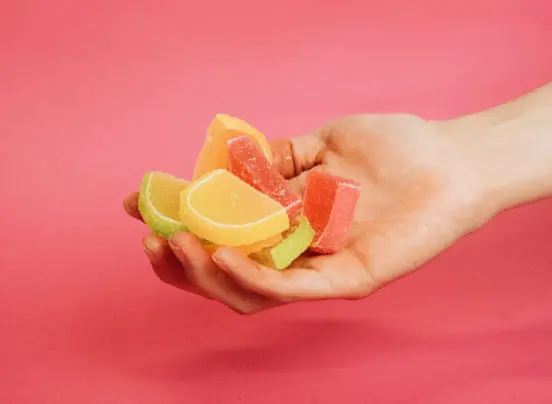
How to use algae products as a vegetarian alternative to conventional gelatine
Algae products are already in use in many industries. The food industry is no exception, and the range does not end with fresh algae. One of the most interesting is their possible uses as an alternative to conventional gelatine.
Since the late 19th century, macro-algae extracts, also known as “algae polysaccharides”, have been used for a variety of purposes – mainly as thickening agents. They offer an answer to the ever-increasing demand for vegetarian and also vegan foods that would otherwise have to resort to gelatine.
The three main representatives of these algae products are agar, alginates and carrageenan.
Although all three derivatives have basically the same origin, i.e. are made from macro algae (also known as seaweed), they differ in many respects. Agar and carrageenan are made from red algae, while alginates are made from brown algae, and this is just the beginning. In addition, there are different places of origin, production methods and physical properties.
Agar, Carrageenan & Alginates – a brief overview of gelatine alternatives
For example, agar is ideal for the production of vegan cheese alternatives. Cheese has a certain consistency that is difficult or impossible to achieve with other gelling agents because agar has the highest gelling strength of all algae-based gelling agents.
Agar is also remeltable, i.e. after solidification, agar can be reheated and regelatinized, which is also known as reversibility.
Carrageenan is used, for example, in dairy products as a stabiliser and emulsifier. This can be seen specifically in the example of chocolate milk. If the milk and the cocoa were mixed without further ado, both ingredients would separate over time and the cocoa would settle on the bottom.
Carrageenan prevents this from happening, because it creates the bond between the proteins in the milk and the cocoa particles, and prevents separation. Carrageenan, however, is more complex and has several subspecies, which we will discuss later.
Alginates are used for foods such as fermented milk products and dressings, as they can be used independently of the pH value.
Alginates are the least commonly used type of macroalgae derivatives. This does not mean, however, that they are less useful. Because they can be manipulated by their electrical charge, it is possible to carry out fine-tuning work on products at the molecular level.
Specific differences of vegetarian gelatine alternatives
Now that one sees the specific application possibilities, one understands that although there are great similarities, the concrete effects and areas are nevertheless very different. As with almost everything, there are different solutions for different problems. However, this is not to be understood as a disadvantage, but helps to find very individualized solutions in many cases.
In order to get a better idea of what the concrete characteristics of the individual gelling agents are in themselves, we will take a look at their properties and origin.
Agar
The primary properties and advantages of agar are its property as a strong gelling agent, its reversibility (“remeltability”) and tolerance for high temperature.
The red algae Gracilaria and Gelidium form the basis for agar. They originate mainly from Europe, North and South America and Asia.
The harvested algae are washed, heated in a prepared water bath and the ingredients are extracted and filtered. The extract is then collected by freezing methods, among others, after which it is dried and ground. The powder obtained is the agar itself.
Agar is used for example in bakery products because of its high temperature tolerance and to prevent the bakery products from drying out, and it is also often seen as an alternative for making vegan cheese.
Carrageenan
In order to go into the primary characteristics, it is useful to look at the three subspecies individually.
- k-Carrageenan: Reacts well with the proteins of dairy products
- i-Carrageenan: Suitable for softer gels, such as foams
- λ-Carrageenan: is not a gelling agent per se, but a thickening agent. Finds its way to for example in juices use.
Carrageenan is formed from several subspecies with different properties, as already mentioned. The most common are k-carrageenan (Kappa), i-carrageenan (Iota) and λ-carrageenan (Lambda). The common feature of these Carrageenan types is that they are all derived from red algae.
Some species are for example Kappaphycus alvarezii, Eucheuma denticulatum and Gigartina skottsbergi. Most of them come from Asia and South America.
Based on the processing method, carrageenan can be categorized into two types: refined and unrefined carrageenan. However, since only refined carrageenan is used in food, we limit the production process to only refined carrageenan. The algae are cleaned and washed before being boiled and filtered in an alkaline solution. The extract then undergoes a concentration process and is finally dried and ground. The final product is refined carrageenan.
Since carrageenan has such a wide range of properties, it is also used in a wide variety of products, for example in fruit juices to regulate viscosity and degree of emulsion, in dairy products as a stabilizer and emulsifier.
Alginates
Alginates, or sodium alginates, are used, among other things, to adhere individual parts to each other. An example of this would be if you want to bring fruits in a dessert into a homogeneous shape, you can use alginates to create this bond. It is also used in ice cream, yoghurt and creams.
Alginate is in itself a unifying term for the salts of alginic acids. These are extracted from brown algae, which include Ascophyllum nodosum, Laminaria digitata and Macrocystis pyrifera. These algae are found in Europe, North and South America and Asia.
The production process of alginate is more complex and requires several chemical steps. First, the salts are pre-extracted from the cell walls of the brown algae and processed into alginic acids. They are then neutralized and further manipulated in further chemical processes to finally yield sodium alginates. Sodium alginates are the most commonly used type of alginate in the food industry.
Algae polysaccharides – solutions for many problems
As can be seen, algae derivatives have a wide range of applications in various areas of the food industry. They are an excellent vegetarian, kosher and halal source of animal gelatine, and can even be used in started products. But the possibilities do not end there, on the contrary, they only start there and offer a wide variety of innovation potential for new products.
In addition, alternatives to animal gelatine based on algae not only open up new production possibilities, but can also compete with gelatine in terms of cost.
We at Alganex will be pleased to help you make a more concrete choice for your product idea and are of course also available to you for any other questions you may have about algae.
Sources:
https://www.researchgate.net/publication/323844190_Seaweed_Polysaccharides_Agar_Alginate_Carrageenan




Comments by [email protected]